Analyzing Health Promotion Strategies for Teenage Obesity in the UK
VerifiedAdded on 2020/07/22
|8
|2181
|67
Report
AI Summary
This report examines a health promotion campaign aimed at reducing teenage obesity in the UK, commissioned by NHS England. It explores the importance of providing health-related information to the public, including teachers, youth workers, and teenagers, to combat poor eating habits and lack of exercise. The report delves into how health beliefs influence teenagers' food consumption and physical activity, utilizing a mediating variable model to understand behavioral changes. It also discusses potential conflicts Ayesha, the public health practitioner, may encounter with the local fast food industry due to the campaign's goals. The report concludes by emphasizing the importance of health promotion in preventing obesity and promoting healthier lifestyles, highlighting the role of routine, physical activity, and informed decision-making in teenagers' health.
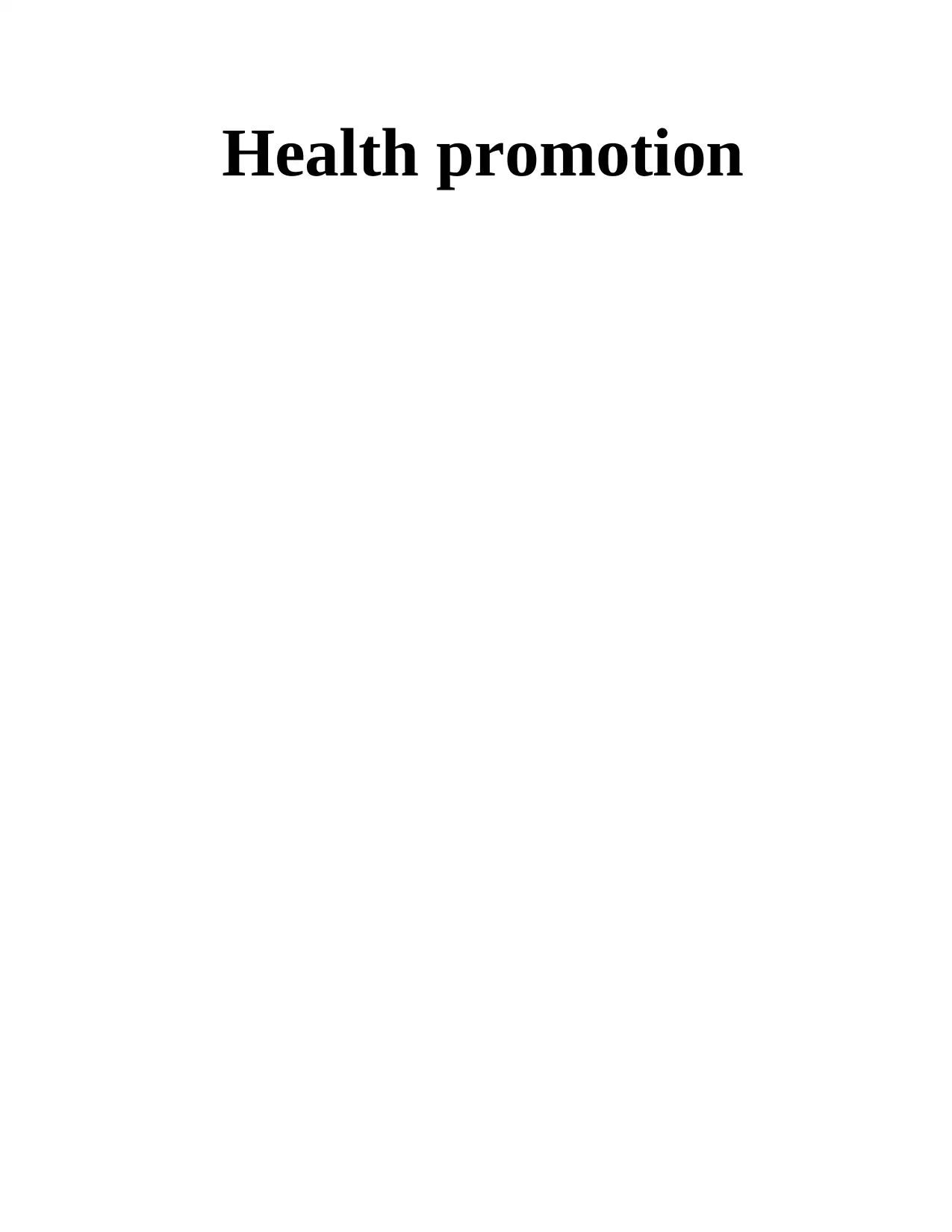
Health promotion
Paraphrase This Document
Need a fresh take? Get an instant paraphrase of this document with our AI Paraphraser
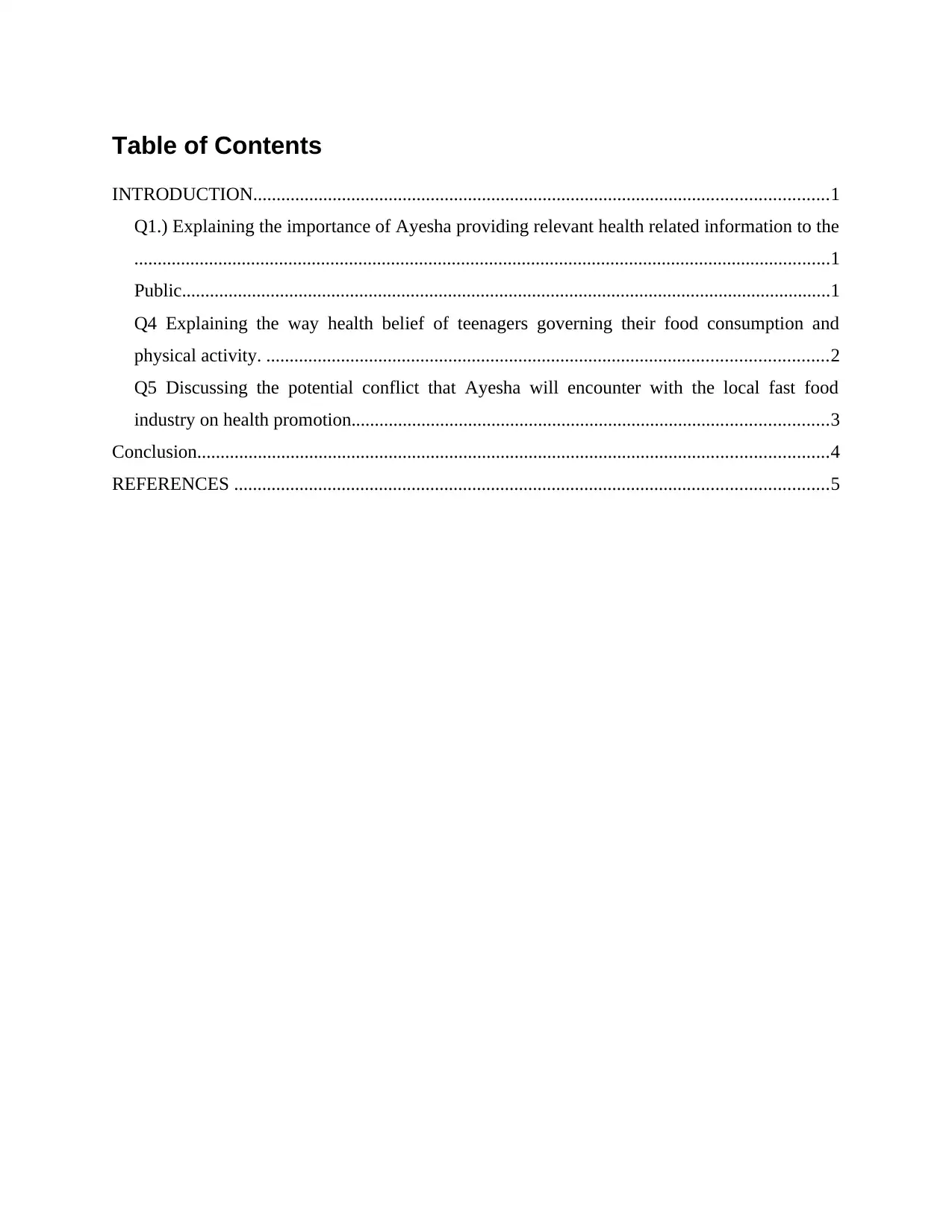
Table of Contents
INTRODUCTION...........................................................................................................................1
Q1.) Explaining the importance of Ayesha providing relevant health related information to the
.....................................................................................................................................................1
Public...........................................................................................................................................1
Q4 Explaining the way health belief of teenagers governing their food consumption and
physical activity. ........................................................................................................................2
Q5 Discussing the potential conflict that Ayesha will encounter with the local fast food
industry on health promotion......................................................................................................3
Conclusion.......................................................................................................................................4
REFERENCES ...............................................................................................................................5
INTRODUCTION...........................................................................................................................1
Q1.) Explaining the importance of Ayesha providing relevant health related information to the
.....................................................................................................................................................1
Public...........................................................................................................................................1
Q4 Explaining the way health belief of teenagers governing their food consumption and
physical activity. ........................................................................................................................2
Q5 Discussing the potential conflict that Ayesha will encounter with the local fast food
industry on health promotion......................................................................................................3
Conclusion.......................................................................................................................................4
REFERENCES ...............................................................................................................................5
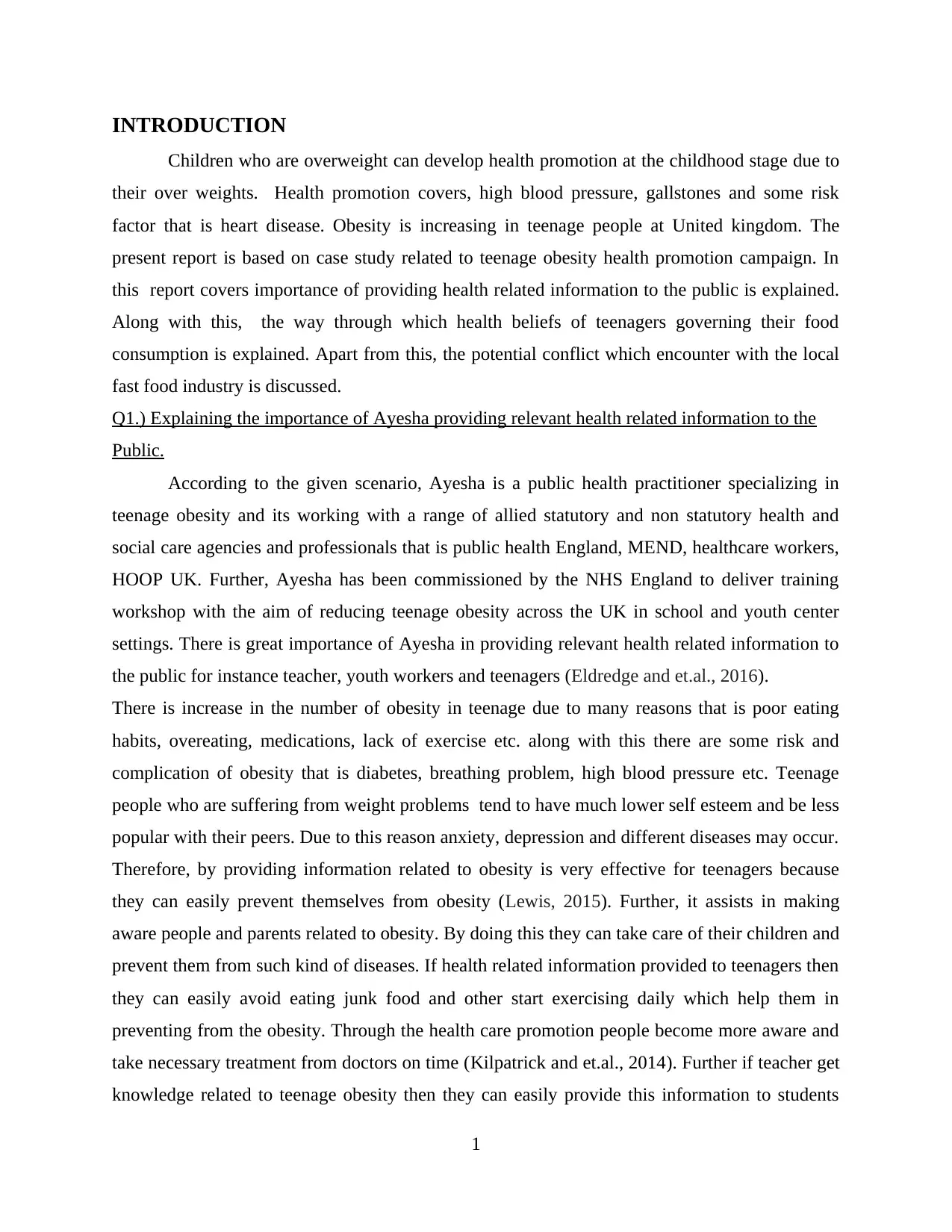
INTRODUCTION
Children who are overweight can develop health promotion at the childhood stage due to
their over weights. Health promotion covers, high blood pressure, gallstones and some risk
factor that is heart disease. Obesity is increasing in teenage people at United kingdom. The
present report is based on case study related to teenage obesity health promotion campaign. In
this report covers importance of providing health related information to the public is explained.
Along with this, the way through which health beliefs of teenagers governing their food
consumption is explained. Apart from this, the potential conflict which encounter with the local
fast food industry is discussed.
Q1.) Explaining the importance of Ayesha providing relevant health related information to the
Public.
According to the given scenario, Ayesha is a public health practitioner specializing in
teenage obesity and its working with a range of allied statutory and non statutory health and
social care agencies and professionals that is public health England, MEND, healthcare workers,
HOOP UK. Further, Ayesha has been commissioned by the NHS England to deliver training
workshop with the aim of reducing teenage obesity across the UK in school and youth center
settings. There is great importance of Ayesha in providing relevant health related information to
the public for instance teacher, youth workers and teenagers (Eldredge and et.al., 2016).
There is increase in the number of obesity in teenage due to many reasons that is poor eating
habits, overeating, medications, lack of exercise etc. along with this there are some risk and
complication of obesity that is diabetes, breathing problem, high blood pressure etc. Teenage
people who are suffering from weight problems tend to have much lower self esteem and be less
popular with their peers. Due to this reason anxiety, depression and different diseases may occur.
Therefore, by providing information related to obesity is very effective for teenagers because
they can easily prevent themselves from obesity (Lewis, 2015). Further, it assists in making
aware people and parents related to obesity. By doing this they can take care of their children and
prevent them from such kind of diseases. If health related information provided to teenagers then
they can easily avoid eating junk food and other start exercising daily which help them in
preventing from the obesity. Through the health care promotion people become more aware and
take necessary treatment from doctors on time (Kilpatrick and et.al., 2014). Further if teacher get
knowledge related to teenage obesity then they can easily provide this information to students
1
Children who are overweight can develop health promotion at the childhood stage due to
their over weights. Health promotion covers, high blood pressure, gallstones and some risk
factor that is heart disease. Obesity is increasing in teenage people at United kingdom. The
present report is based on case study related to teenage obesity health promotion campaign. In
this report covers importance of providing health related information to the public is explained.
Along with this, the way through which health beliefs of teenagers governing their food
consumption is explained. Apart from this, the potential conflict which encounter with the local
fast food industry is discussed.
Q1.) Explaining the importance of Ayesha providing relevant health related information to the
Public.
According to the given scenario, Ayesha is a public health practitioner specializing in
teenage obesity and its working with a range of allied statutory and non statutory health and
social care agencies and professionals that is public health England, MEND, healthcare workers,
HOOP UK. Further, Ayesha has been commissioned by the NHS England to deliver training
workshop with the aim of reducing teenage obesity across the UK in school and youth center
settings. There is great importance of Ayesha in providing relevant health related information to
the public for instance teacher, youth workers and teenagers (Eldredge and et.al., 2016).
There is increase in the number of obesity in teenage due to many reasons that is poor eating
habits, overeating, medications, lack of exercise etc. along with this there are some risk and
complication of obesity that is diabetes, breathing problem, high blood pressure etc. Teenage
people who are suffering from weight problems tend to have much lower self esteem and be less
popular with their peers. Due to this reason anxiety, depression and different diseases may occur.
Therefore, by providing information related to obesity is very effective for teenagers because
they can easily prevent themselves from obesity (Lewis, 2015). Further, it assists in making
aware people and parents related to obesity. By doing this they can take care of their children and
prevent them from such kind of diseases. If health related information provided to teenagers then
they can easily avoid eating junk food and other start exercising daily which help them in
preventing from the obesity. Through the health care promotion people become more aware and
take necessary treatment from doctors on time (Kilpatrick and et.al., 2014). Further if teacher get
knowledge related to teenage obesity then they can easily provide this information to students
1
⊘ This is a preview!⊘
Do you want full access?
Subscribe today to unlock all pages.

Trusted by 1+ million students worldwide
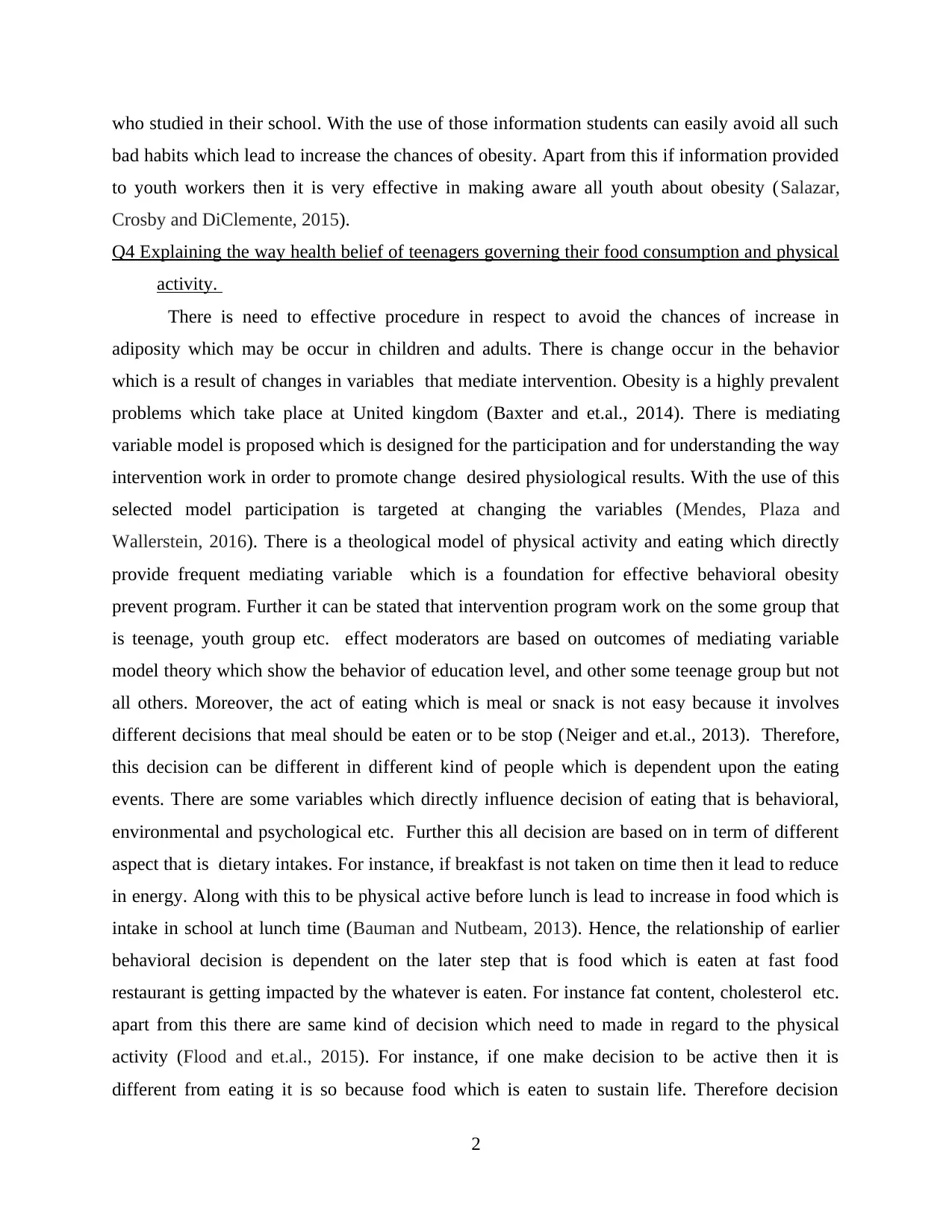
who studied in their school. With the use of those information students can easily avoid all such
bad habits which lead to increase the chances of obesity. Apart from this if information provided
to youth workers then it is very effective in making aware all youth about obesity (Salazar,
Crosby and DiClemente, 2015).
Q4 Explaining the way health belief of teenagers governing their food consumption and physical
activity.
There is need to effective procedure in respect to avoid the chances of increase in
adiposity which may be occur in children and adults. There is change occur in the behavior
which is a result of changes in variables that mediate intervention. Obesity is a highly prevalent
problems which take place at United kingdom (Baxter and et.al., 2014). There is mediating
variable model is proposed which is designed for the participation and for understanding the way
intervention work in order to promote change desired physiological results. With the use of this
selected model participation is targeted at changing the variables (Mendes, Plaza and
Wallerstein, 2016). There is a theological model of physical activity and eating which directly
provide frequent mediating variable which is a foundation for effective behavioral obesity
prevent program. Further it can be stated that intervention program work on the some group that
is teenage, youth group etc. effect moderators are based on outcomes of mediating variable
model theory which show the behavior of education level, and other some teenage group but not
all others. Moreover, the act of eating which is meal or snack is not easy because it involves
different decisions that meal should be eaten or to be stop (Neiger and et.al., 2013). Therefore,
this decision can be different in different kind of people which is dependent upon the eating
events. There are some variables which directly influence decision of eating that is behavioral,
environmental and psychological etc. Further this all decision are based on in term of different
aspect that is dietary intakes. For instance, if breakfast is not taken on time then it lead to reduce
in energy. Along with this to be physical active before lunch is lead to increase in food which is
intake in school at lunch time (Bauman and Nutbeam, 2013). Hence, the relationship of earlier
behavioral decision is dependent on the later step that is food which is eaten at fast food
restaurant is getting impacted by the whatever is eaten. For instance fat content, cholesterol etc.
apart from this there are same kind of decision which need to made in regard to the physical
activity (Flood and et.al., 2015). For instance, if one make decision to be active then it is
different from eating it is so because food which is eaten to sustain life. Therefore decision
2
bad habits which lead to increase the chances of obesity. Apart from this if information provided
to youth workers then it is very effective in making aware all youth about obesity (Salazar,
Crosby and DiClemente, 2015).
Q4 Explaining the way health belief of teenagers governing their food consumption and physical
activity.
There is need to effective procedure in respect to avoid the chances of increase in
adiposity which may be occur in children and adults. There is change occur in the behavior
which is a result of changes in variables that mediate intervention. Obesity is a highly prevalent
problems which take place at United kingdom (Baxter and et.al., 2014). There is mediating
variable model is proposed which is designed for the participation and for understanding the way
intervention work in order to promote change desired physiological results. With the use of this
selected model participation is targeted at changing the variables (Mendes, Plaza and
Wallerstein, 2016). There is a theological model of physical activity and eating which directly
provide frequent mediating variable which is a foundation for effective behavioral obesity
prevent program. Further it can be stated that intervention program work on the some group that
is teenage, youth group etc. effect moderators are based on outcomes of mediating variable
model theory which show the behavior of education level, and other some teenage group but not
all others. Moreover, the act of eating which is meal or snack is not easy because it involves
different decisions that meal should be eaten or to be stop (Neiger and et.al., 2013). Therefore,
this decision can be different in different kind of people which is dependent upon the eating
events. There are some variables which directly influence decision of eating that is behavioral,
environmental and psychological etc. Further this all decision are based on in term of different
aspect that is dietary intakes. For instance, if breakfast is not taken on time then it lead to reduce
in energy. Along with this to be physical active before lunch is lead to increase in food which is
intake in school at lunch time (Bauman and Nutbeam, 2013). Hence, the relationship of earlier
behavioral decision is dependent on the later step that is food which is eaten at fast food
restaurant is getting impacted by the whatever is eaten. For instance fat content, cholesterol etc.
apart from this there are same kind of decision which need to made in regard to the physical
activity (Flood and et.al., 2015). For instance, if one make decision to be active then it is
different from eating it is so because food which is eaten to sustain life. Therefore decision
2
Paraphrase This Document
Need a fresh take? Get an instant paraphrase of this document with our AI Paraphraser
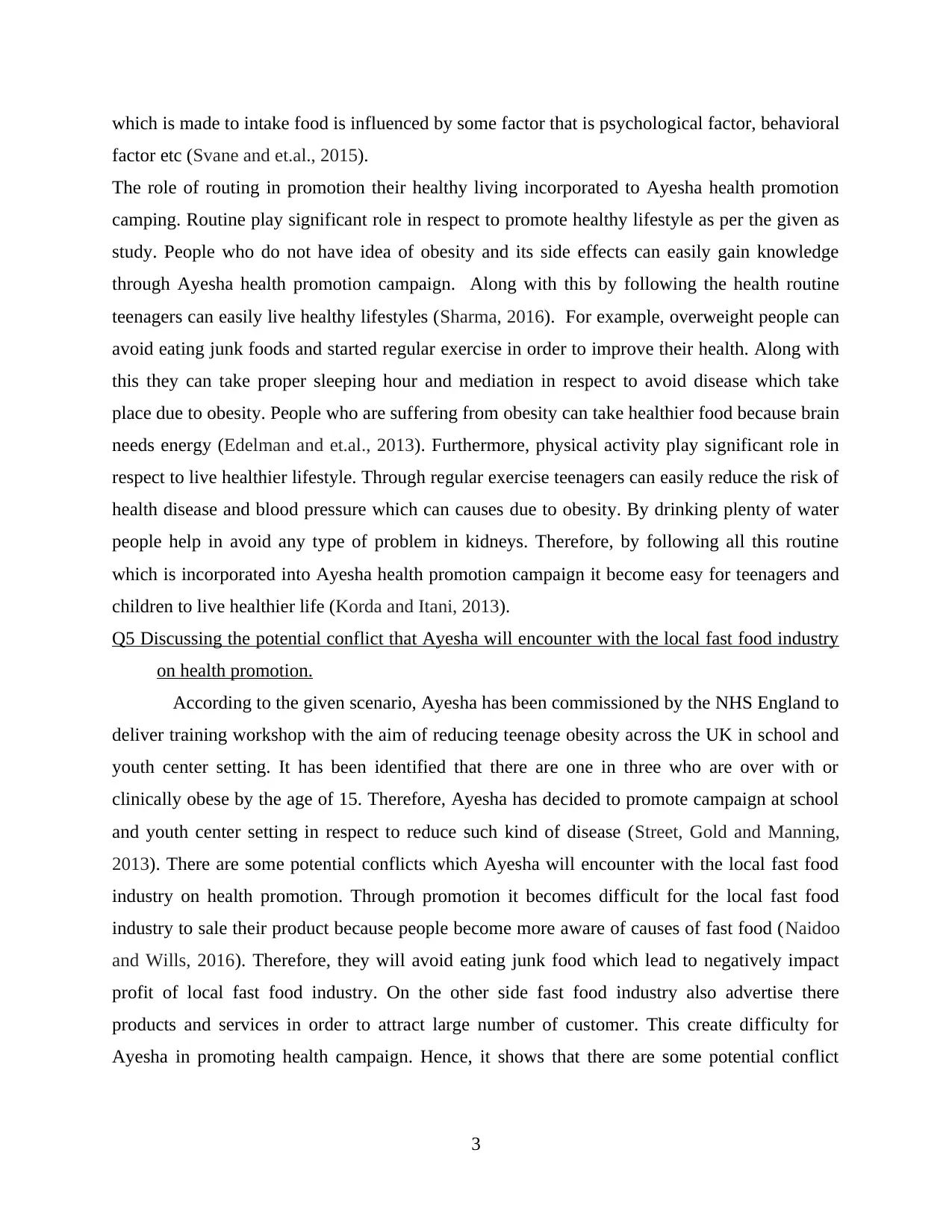
which is made to intake food is influenced by some factor that is psychological factor, behavioral
factor etc (Svane and et.al., 2015).
The role of routing in promotion their healthy living incorporated to Ayesha health promotion
camping. Routine play significant role in respect to promote healthy lifestyle as per the given as
study. People who do not have idea of obesity and its side effects can easily gain knowledge
through Ayesha health promotion campaign. Along with this by following the health routine
teenagers can easily live healthy lifestyles (Sharma, 2016). For example, overweight people can
avoid eating junk foods and started regular exercise in order to improve their health. Along with
this they can take proper sleeping hour and mediation in respect to avoid disease which take
place due to obesity. People who are suffering from obesity can take healthier food because brain
needs energy (Edelman and et.al., 2013). Furthermore, physical activity play significant role in
respect to live healthier lifestyle. Through regular exercise teenagers can easily reduce the risk of
health disease and blood pressure which can causes due to obesity. By drinking plenty of water
people help in avoid any type of problem in kidneys. Therefore, by following all this routine
which is incorporated into Ayesha health promotion campaign it become easy for teenagers and
children to live healthier life (Korda and Itani, 2013).
Q5 Discussing the potential conflict that Ayesha will encounter with the local fast food industry
on health promotion.
According to the given scenario, Ayesha has been commissioned by the NHS England to
deliver training workshop with the aim of reducing teenage obesity across the UK in school and
youth center setting. It has been identified that there are one in three who are over with or
clinically obese by the age of 15. Therefore, Ayesha has decided to promote campaign at school
and youth center setting in respect to reduce such kind of disease (Street, Gold and Manning,
2013). There are some potential conflicts which Ayesha will encounter with the local fast food
industry on health promotion. Through promotion it becomes difficult for the local fast food
industry to sale their product because people become more aware of causes of fast food (Naidoo
and Wills, 2016). Therefore, they will avoid eating junk food which lead to negatively impact
profit of local fast food industry. On the other side fast food industry also advertise there
products and services in order to attract large number of customer. This create difficulty for
Ayesha in promoting health campaign. Hence, it shows that there are some potential conflict
3
factor etc (Svane and et.al., 2015).
The role of routing in promotion their healthy living incorporated to Ayesha health promotion
camping. Routine play significant role in respect to promote healthy lifestyle as per the given as
study. People who do not have idea of obesity and its side effects can easily gain knowledge
through Ayesha health promotion campaign. Along with this by following the health routine
teenagers can easily live healthy lifestyles (Sharma, 2016). For example, overweight people can
avoid eating junk foods and started regular exercise in order to improve their health. Along with
this they can take proper sleeping hour and mediation in respect to avoid disease which take
place due to obesity. People who are suffering from obesity can take healthier food because brain
needs energy (Edelman and et.al., 2013). Furthermore, physical activity play significant role in
respect to live healthier lifestyle. Through regular exercise teenagers can easily reduce the risk of
health disease and blood pressure which can causes due to obesity. By drinking plenty of water
people help in avoid any type of problem in kidneys. Therefore, by following all this routine
which is incorporated into Ayesha health promotion campaign it become easy for teenagers and
children to live healthier life (Korda and Itani, 2013).
Q5 Discussing the potential conflict that Ayesha will encounter with the local fast food industry
on health promotion.
According to the given scenario, Ayesha has been commissioned by the NHS England to
deliver training workshop with the aim of reducing teenage obesity across the UK in school and
youth center setting. It has been identified that there are one in three who are over with or
clinically obese by the age of 15. Therefore, Ayesha has decided to promote campaign at school
and youth center setting in respect to reduce such kind of disease (Street, Gold and Manning,
2013). There are some potential conflicts which Ayesha will encounter with the local fast food
industry on health promotion. Through promotion it becomes difficult for the local fast food
industry to sale their product because people become more aware of causes of fast food (Naidoo
and Wills, 2016). Therefore, they will avoid eating junk food which lead to negatively impact
profit of local fast food industry. On the other side fast food industry also advertise there
products and services in order to attract large number of customer. This create difficulty for
Ayesha in promoting health campaign. Hence, it shows that there are some potential conflict
3
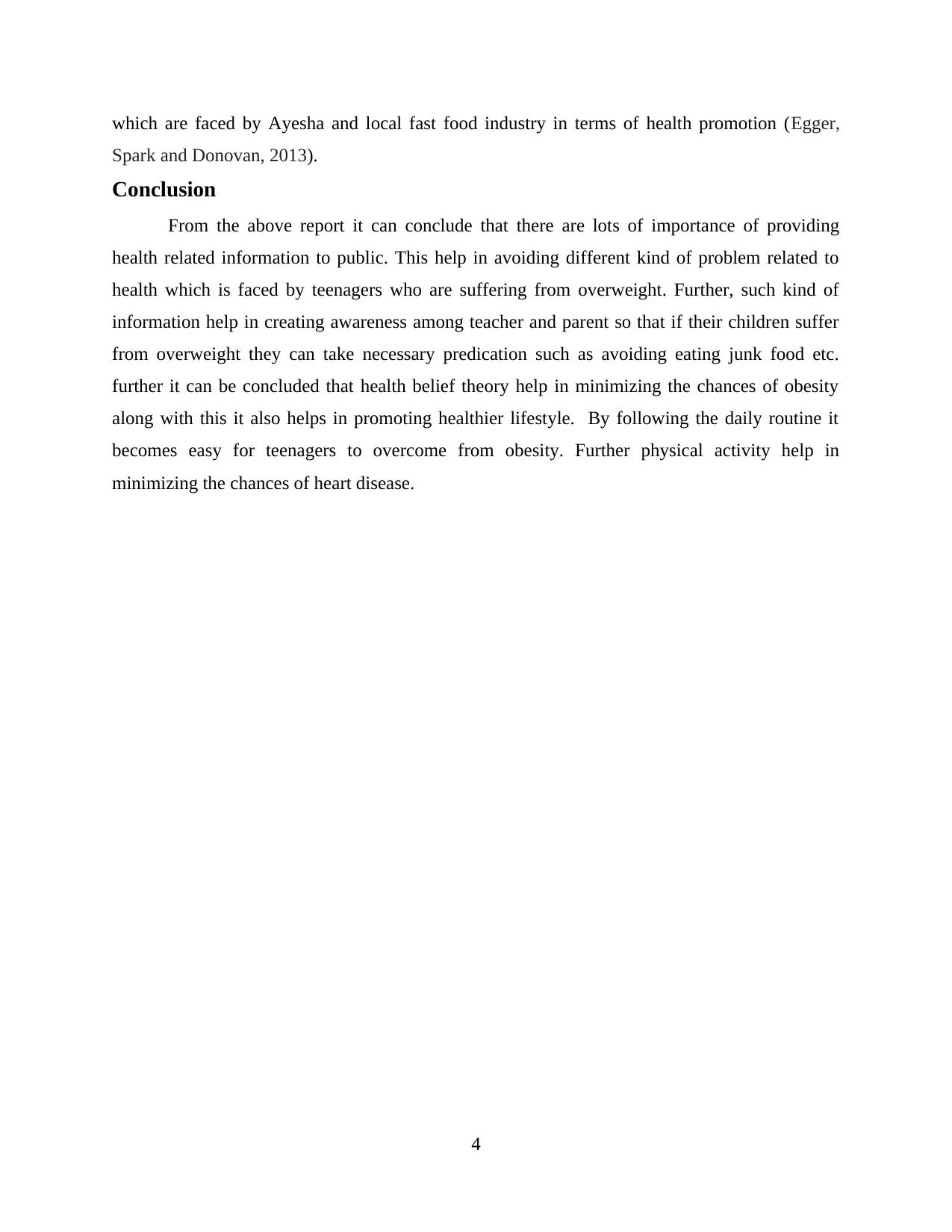
which are faced by Ayesha and local fast food industry in terms of health promotion (Egger,
Spark and Donovan, 2013).
Conclusion
From the above report it can conclude that there are lots of importance of providing
health related information to public. This help in avoiding different kind of problem related to
health which is faced by teenagers who are suffering from overweight. Further, such kind of
information help in creating awareness among teacher and parent so that if their children suffer
from overweight they can take necessary predication such as avoiding eating junk food etc.
further it can be concluded that health belief theory help in minimizing the chances of obesity
along with this it also helps in promoting healthier lifestyle. By following the daily routine it
becomes easy for teenagers to overcome from obesity. Further physical activity help in
minimizing the chances of heart disease.
4
Spark and Donovan, 2013).
Conclusion
From the above report it can conclude that there are lots of importance of providing
health related information to public. This help in avoiding different kind of problem related to
health which is faced by teenagers who are suffering from overweight. Further, such kind of
information help in creating awareness among teacher and parent so that if their children suffer
from overweight they can take necessary predication such as avoiding eating junk food etc.
further it can be concluded that health belief theory help in minimizing the chances of obesity
along with this it also helps in promoting healthier lifestyle. By following the daily routine it
becomes easy for teenagers to overcome from obesity. Further physical activity help in
minimizing the chances of heart disease.
4
⊘ This is a preview!⊘
Do you want full access?
Subscribe today to unlock all pages.

Trusted by 1+ million students worldwide
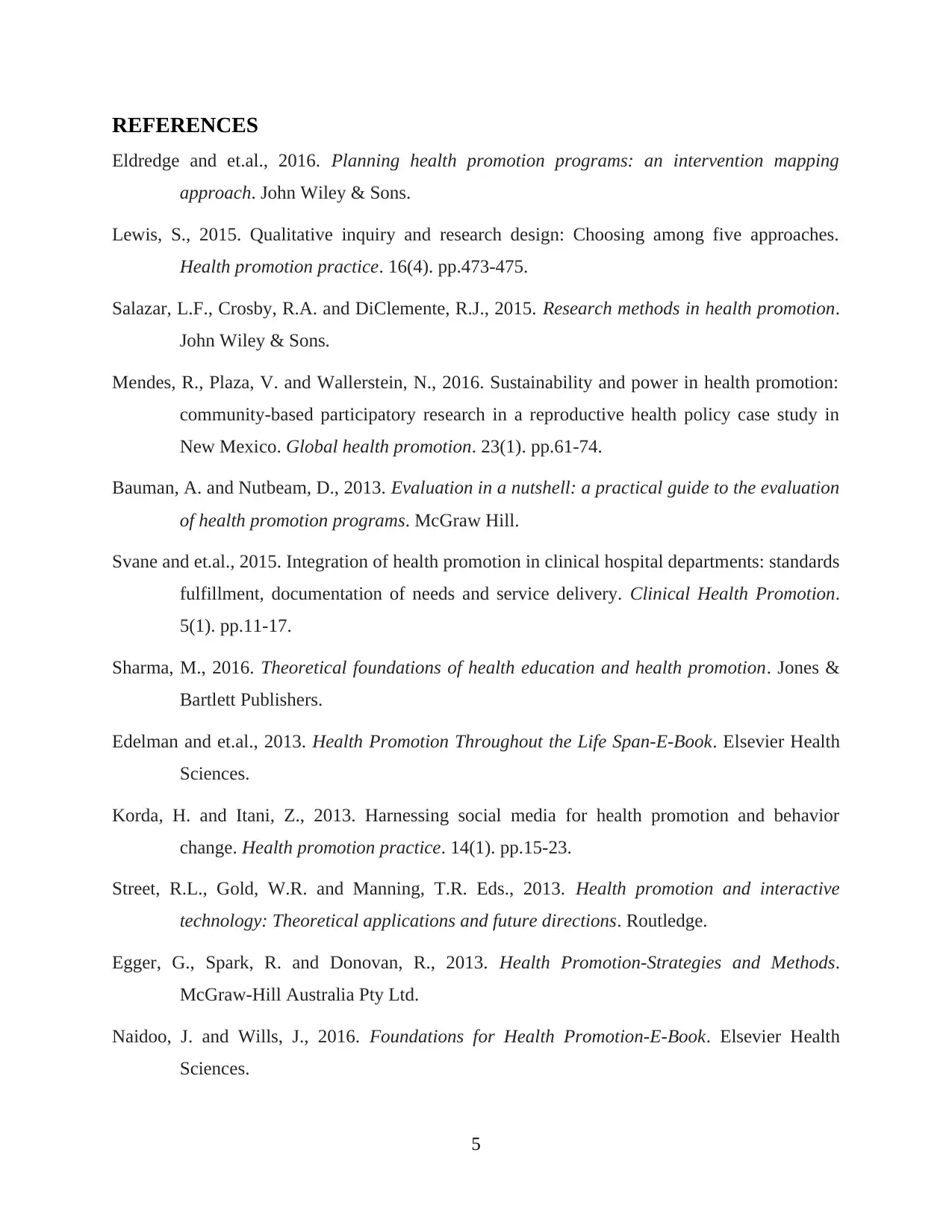
REFERENCES
Eldredge and et.al., 2016. Planning health promotion programs: an intervention mapping
approach. John Wiley & Sons.
Lewis, S., 2015. Qualitative inquiry and research design: Choosing among five approaches.
Health promotion practice. 16(4). pp.473-475.
Salazar, L.F., Crosby, R.A. and DiClemente, R.J., 2015. Research methods in health promotion.
John Wiley & Sons.
Mendes, R., Plaza, V. and Wallerstein, N., 2016. Sustainability and power in health promotion:
community-based participatory research in a reproductive health policy case study in
New Mexico. Global health promotion. 23(1). pp.61-74.
Bauman, A. and Nutbeam, D., 2013. Evaluation in a nutshell: a practical guide to the evaluation
of health promotion programs. McGraw Hill.
Svane and et.al., 2015. Integration of health promotion in clinical hospital departments: standards
fulfillment, documentation of needs and service delivery. Clinical Health Promotion.
5(1). pp.11-17.
Sharma, M., 2016. Theoretical foundations of health education and health promotion. Jones &
Bartlett Publishers.
Edelman and et.al., 2013. Health Promotion Throughout the Life Span-E-Book. Elsevier Health
Sciences.
Korda, H. and Itani, Z., 2013. Harnessing social media for health promotion and behavior
change. Health promotion practice. 14(1). pp.15-23.
Street, R.L., Gold, W.R. and Manning, T.R. Eds., 2013. Health promotion and interactive
technology: Theoretical applications and future directions. Routledge.
Egger, G., Spark, R. and Donovan, R., 2013. Health Promotion-Strategies and Methods.
McGraw-Hill Australia Pty Ltd.
Naidoo, J. and Wills, J., 2016. Foundations for Health Promotion-E-Book. Elsevier Health
Sciences.
5
Eldredge and et.al., 2016. Planning health promotion programs: an intervention mapping
approach. John Wiley & Sons.
Lewis, S., 2015. Qualitative inquiry and research design: Choosing among five approaches.
Health promotion practice. 16(4). pp.473-475.
Salazar, L.F., Crosby, R.A. and DiClemente, R.J., 2015. Research methods in health promotion.
John Wiley & Sons.
Mendes, R., Plaza, V. and Wallerstein, N., 2016. Sustainability and power in health promotion:
community-based participatory research in a reproductive health policy case study in
New Mexico. Global health promotion. 23(1). pp.61-74.
Bauman, A. and Nutbeam, D., 2013. Evaluation in a nutshell: a practical guide to the evaluation
of health promotion programs. McGraw Hill.
Svane and et.al., 2015. Integration of health promotion in clinical hospital departments: standards
fulfillment, documentation of needs and service delivery. Clinical Health Promotion.
5(1). pp.11-17.
Sharma, M., 2016. Theoretical foundations of health education and health promotion. Jones &
Bartlett Publishers.
Edelman and et.al., 2013. Health Promotion Throughout the Life Span-E-Book. Elsevier Health
Sciences.
Korda, H. and Itani, Z., 2013. Harnessing social media for health promotion and behavior
change. Health promotion practice. 14(1). pp.15-23.
Street, R.L., Gold, W.R. and Manning, T.R. Eds., 2013. Health promotion and interactive
technology: Theoretical applications and future directions. Routledge.
Egger, G., Spark, R. and Donovan, R., 2013. Health Promotion-Strategies and Methods.
McGraw-Hill Australia Pty Ltd.
Naidoo, J. and Wills, J., 2016. Foundations for Health Promotion-E-Book. Elsevier Health
Sciences.
5
Paraphrase This Document
Need a fresh take? Get an instant paraphrase of this document with our AI Paraphraser
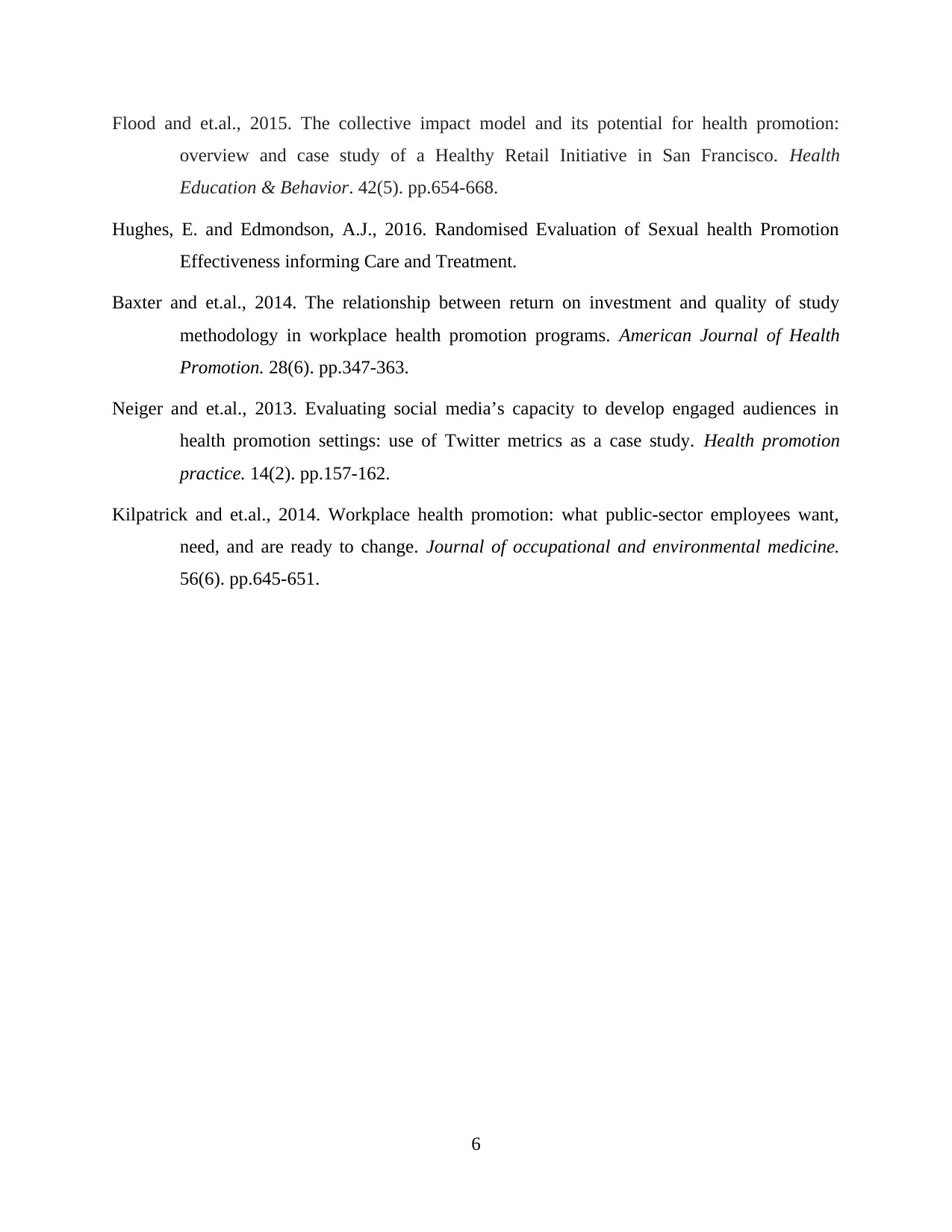
Flood and et.al., 2015. The collective impact model and its potential for health promotion:
overview and case study of a Healthy Retail Initiative in San Francisco. Health
Education & Behavior. 42(5). pp.654-668.
Hughes, E. and Edmondson, A.J., 2016. Randomised Evaluation of Sexual health Promotion
Effectiveness informing Care and Treatment.
Baxter and et.al., 2014. The relationship between return on investment and quality of study
methodology in workplace health promotion programs. American Journal of Health
Promotion. 28(6). pp.347-363.
Neiger and et.al., 2013. Evaluating social media’s capacity to develop engaged audiences in
health promotion settings: use of Twitter metrics as a case study. Health promotion
practice. 14(2). pp.157-162.
Kilpatrick and et.al., 2014. Workplace health promotion: what public-sector employees want,
need, and are ready to change. Journal of occupational and environmental medicine.
56(6). pp.645-651.
6
overview and case study of a Healthy Retail Initiative in San Francisco. Health
Education & Behavior. 42(5). pp.654-668.
Hughes, E. and Edmondson, A.J., 2016. Randomised Evaluation of Sexual health Promotion
Effectiveness informing Care and Treatment.
Baxter and et.al., 2014. The relationship between return on investment and quality of study
methodology in workplace health promotion programs. American Journal of Health
Promotion. 28(6). pp.347-363.
Neiger and et.al., 2013. Evaluating social media’s capacity to develop engaged audiences in
health promotion settings: use of Twitter metrics as a case study. Health promotion
practice. 14(2). pp.157-162.
Kilpatrick and et.al., 2014. Workplace health promotion: what public-sector employees want,
need, and are ready to change. Journal of occupational and environmental medicine.
56(6). pp.645-651.
6
1 out of 8
Related Documents
Your All-in-One AI-Powered Toolkit for Academic Success.
+13062052269
info@desklib.com
Available 24*7 on WhatsApp / Email
![[object Object]](/_next/static/media/star-bottom.7253800d.svg)
Unlock your academic potential
Copyright © 2020–2025 A2Z Services. All Rights Reserved. Developed and managed by ZUCOL.





